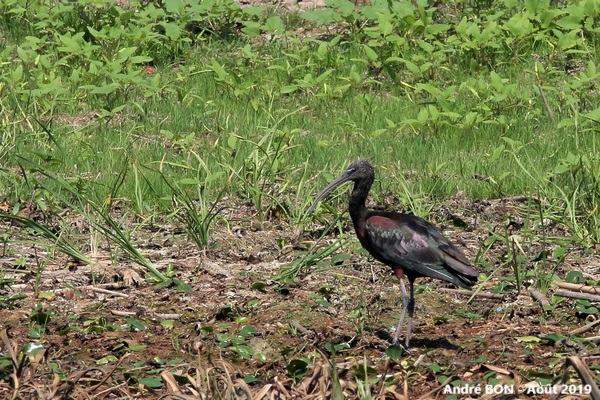



| Glossy Ibis (Plegadis falcinellus (Linnaeus, 1766)) |




|
|
Scientific name: Plegadis falcinellus (Linnaeus, 1766) Common name: Glossy Ibis French name: Ibis falcinelle Order: Pelecaniformes Family: Threskiornithidae Size: Body size: 48 to 66 cm; Weight: 485 to 970 g; Wingspan: 80 to 105 cm. Habitat: Shallow, swamps, pools, ponds, lakes and rivers, tree-lined for nesting. Food: Worms, molluscs, larvae and insects collected in the mud thanks to the long downcurved beak. Nesting: The Glossy Ibis nests in colonies often with other wetland species, herons, spoonbills or cormorants. The nest built with twigs is located in a tree or in a reed bed. There are 3 or 4 eggs per clutch. Migration: Birds from Central Europe migrate to the Sahel, East Africa or Pakistan and India in winter. Other birds are sedentary. Geographic area: Central Europe. Africa and Australia except desert areas, South-East Asia, tropical America, Florida, Antilles. |
The Glossy Ibis has a dark rusty brown plumage with green metallic highlights. In breeding plumage, the head, neck, upper back and underparts are bright chestnut. The bill is long, thin and downcurved. It is brownish-grey in colour. A thin bluish ridge extends from the base of the bill to the eye and from the eye to the top of the bill. The legs are long and blackish. The plumage is duller outside the breeding season. |
| [To know more about the Glossy Ibis] [Next picture] [Top] |

|
We only stayed one day in the Danube Delta but we saw many Glossy Ibises there. |
| [To know more about the Glossy Ibis] [Next picture] [Previous picture] [Top] |

|
The long, downcurved beak is used to probe the mud for food. |
| [To know more about the Glossy Ibis] [Next picture] [Previous picture] [Top] |

|
The plumage is quite dark but adorned with beautiful bronze and metallic green reflections. |
| [To know more about the Glossy Ibis] [Previous picture] [Top] |

|
Glossy Ibises search for food in shallow water. |